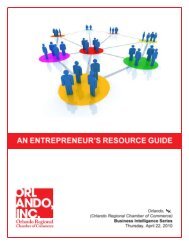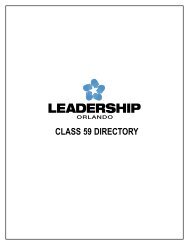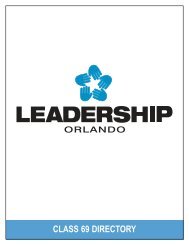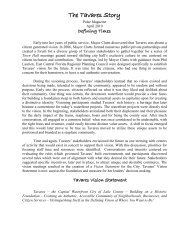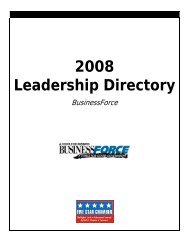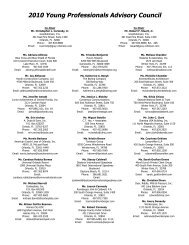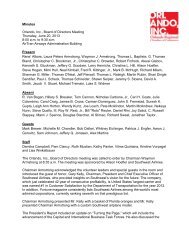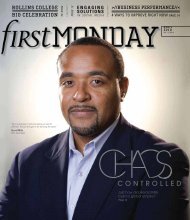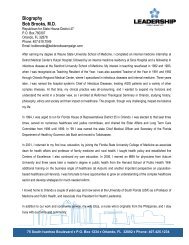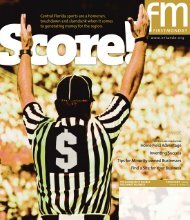FM Oct 04 PDF - Orlando Chamber of Commerce
FM Oct 04 PDF - Orlando Chamber of Commerce
FM Oct 04 PDF - Orlando Chamber of Commerce
Create successful ePaper yourself
Turn your PDF publications into a flip-book with our unique Google optimized e-Paper software.
COVER STORY<br />
THE ART OF<br />
ATTENDANCE<br />
<strong>Orlando</strong>'s arts groups join forces to build<br />
audiences and create a cultural movement.<br />
By Tracey Velt<br />
When Electronic Arts (EA) wanted<br />
to attract graduates from the Ringling<br />
School <strong>of</strong> Arts in Sarasota to design video<br />
games at its Maitland-based studio, the<br />
multimedia company didn’t focus solely<br />
on selling itself as a great place to work.<br />
Instead, it gave potential job candidates a<br />
run down <strong>of</strong> all the museums, festivals,<br />
theaters and other cultural activities<br />
available in the Central Florida region.<br />
As a result, 13 Ringling graduates<br />
are now employed at EA’s local studio.<br />
When it comes to attracting businesses<br />
to Central Florida, don’t underestimate<br />
the power <strong>of</strong> a solid arts and culture<br />
community. A diverse and deep cultural<br />
environment helps to grow, attract and<br />
retain businesses and knowledge workers.<br />
The economic impact <strong>of</strong> the arts is<br />
substantial. In fact, studies show the<br />
direct impact <strong>of</strong> the arts on Central<br />
Florida as $135 million.<br />
“When people go out, they spend<br />
money on parking, a babysitter and<br />
eating dinner,” says Margot H. Knight,<br />
President and CEO <strong>of</strong> United Arts <strong>of</strong><br />
Central Florida. “That money includes<br />
all the spending that those groups do<br />
in the community.”<br />
As a result, Central Florida has<br />
2,000 people employed in arts and<br />
culture equaling $42 million in wages.<br />
The arts generate spending <strong>of</strong> about<br />
$300 million annually.<br />
“The region has the cultural foundation<br />
needed to attract these workers and<br />
more potential income,” says Ray Gilley,<br />
President and CEO <strong>of</strong> the Metro <strong>Orlando</strong><br />
Economic Development Commission.<br />
“What they’re missing are the resources<br />
to get the word out to the community.”<br />
That’s why United Arts, the Central<br />
Florida Performing Arts Alliance and the<br />
<strong>Orlando</strong>/Orange County Convention and<br />
Visitors Bureau recently joined forces to<br />
form the Cultural Audience Development<br />
Initiative, a plan to increase participation in<br />
the abundant number <strong>of</strong> arts and cultural<br />
activities in the Central Florida region.<br />
Getting the Ball Rolling<br />
In <strong>Oct</strong>ober 2001, community leaders<br />
such as Knight and Gilley started looking<br />
at the arts groups and realized that, due<br />
to lack <strong>of</strong> funds, only a few groups had<br />
a strategic marketing plan. As a result,<br />
most <strong>of</strong> the region’s high-quality cultural<br />
<strong>of</strong>ferings were the best kept secret in<br />
Central Florida. Not a good place to be<br />
when your livelihood relies on ticket sales<br />
and audience participation.<br />
Knight decided to take action.<br />
“Margot approached the Central<br />
Florida Performing Arts Alliance, knowing<br />
we attempted a half-price ticket booth in<br />
downtown <strong>Orlando</strong> and were fighting<br />
for a way to stimulate more audience<br />
participation,” says Jim Morris, Executive<br />
Director <strong>of</strong> the Central Florida Performing<br />
Arts Alliance. “Since <strong>Orlando</strong> isn’t a<br />
walking downtown, we knew the ticket<br />
booth wasn’t viable, so this was our opportunity<br />
to come up with some new ideas.”<br />
She also approached the Convention<br />
and Visitor’s Bureau, thinking it was a<br />
natural partner as visitors are always<br />
looking for different things to do when<br />
they’re in Central Florida.<br />
“We jumped in right away because we<br />
saw this as an opportunity to not only<br />
build a great tool for locals, but for the<br />
tourists as well,” says Peter Cranis, Vice<br />
President <strong>of</strong> Consumer Marketing <strong>of</strong> the<br />
<strong>Orlando</strong>/Orange County Convention and<br />
Visitors Bureau. “Long term, we hope it<br />
will generate increased repeat visitation and<br />
possibly encourage people to come back<br />
sooner because <strong>of</strong> all there is to do here.”<br />
“You don’t have to go to New York City to see good theater, and<br />
this initiative will help Central Floridians realize they’re sitting on<br />
something fabulous and affordable.”<br />
— Ruth Katz<br />
Director <strong>of</strong> Marketing, <strong>Orlando</strong> Ballet<br />
Raising Money<br />
As with anything else, it takes<br />
money to do great research, which is the<br />
cornerstone <strong>of</strong> any successful initiative.<br />
The Elizabeth Morse Foundation, along<br />
with some other groups, underwrote an<br />
analysis <strong>of</strong> the cultural audiences in the<br />
Central Florida region.<br />
“We invited any group who wanted to<br />
participate,” says Knight. “We ended up<br />
with 30 groups.”<br />
The underwriters put together a<br />
psychological analysis <strong>of</strong> those 30 groups<br />
and their audiences, and as a result got a<br />
better handle on who was coming and<br />
who might come to the different cultural<br />
venues. From that research, Knight says<br />
they identified 10 areas where they<br />
could “move the needle” on audience<br />
Photo by Richard Aguilar<br />
participation. Only 11 percent <strong>of</strong> the<br />
target market was attending Central<br />
Florida’s cultural performances. Knight<br />
believes that in a rising cultural city, that<br />
participation should be 18 to 20 percent.<br />
The goal is to be at 20 percent in three<br />
to five years. “We’ve taken the research as<br />
a catalyst to advance us and catch up to<br />
what some other cities are already doing,”<br />
adds Morris.<br />
That research is helping other organizations<br />
pinpoint their target audience so<br />
marketing can be better directed. “My<br />
challenge is to bring the ballet to the<br />
people,” says Ruth Katz, Director <strong>of</strong><br />
Marketing <strong>of</strong> the <strong>Orlando</strong> Ballet. “You<br />
don’t have to go to New York City to see<br />
good theater, and this initiative will help<br />
Central Floridians realize they’re sitting<br />
on something fabulous and affordable.”<br />
The biggest challenge has been to<br />
widen the geographical boundaries <strong>of</strong><br />
the cultural audience base and to introduce<br />
a younger population to theatre and<br />
cultural arts. With more and more schools<br />
dropping performing arts and music<br />
from their curriculums, many pre-teens,<br />
high-schoolers and even college students<br />
are unaware <strong>of</strong> cultural and entertainment<br />
<strong>of</strong>ferings beyond television, movies, rock<br />
concerts and video games.<br />
“We have no problem in attracting<br />
our older generations to the theater.<br />
The challenge is to excite, entertain, and<br />
enrich a whole new generation,” says Rick<br />
Traum, Executive Director <strong>of</strong> The Mount<br />
continued on page 22<br />
18 OCTOBER 20<strong>04</strong> <strong>FM</strong>



